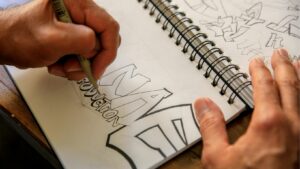Arte:95kxuexyvay= Dibujos
Drawing art is a timeless form of expression that transcends cultures and eras, capturing the imagination of both artists and admirers  alike. With just a pencil and paper, artists transform their thoughts and emotions into visual stories, creating a unique language that speaks to the soul. This powerful medium offers endless opportunities for creativity and personal growth, making it accessible for everyone, from beginners to seasoned professionals.
alike. With just a pencil and paper, artists transform their thoughts and emotions into visual stories, creating a unique language that speaks to the soul. This powerful medium offers endless opportunities for creativity and personal growth, making it accessible for everyone, from beginners to seasoned professionals.
In a world where digital art is on the rise, traditional drawing remains a cherished practice, celebrated for its raw authenticity and tactile nature. Whether sketching a simple portrait or crafting intricate landscapes, drawing encourages mindfulness and enhances observational skills. It’s a journey of exploration, where each stroke reveals a deeper understanding of the subject and oneself. As more people seek creative outlets in their daily lives, drawing art continues to inspire and connect individuals across the globe.
Understanding Drawing Art
Drawing art involves creating images on a surface using tools like pencils, pens, or charcoal. It’s among the most fundamental forms of  visual expression, allowing artists to communicate ideas and emotions through lines and shapes. Historically, drawing has played a crucial role in the development of various art forms. By mastering drawing, artists have laid the groundwork for painting, sculpture, and architecture.
visual expression, allowing artists to communicate ideas and emotions through lines and shapes. Historically, drawing has played a crucial role in the development of various art forms. By mastering drawing, artists have laid the groundwork for painting, sculpture, and architecture.
Various techniques and styles in drawing art cater to different skill levels and creative goals. Line drawing involves using lines to define forms and convey movement, while shading adds depth and dimension. Cross-hatching, stippling, and contouring are techniques that enhance texture and detail. Styles such as realism, abstract, and caricature offer diverse approaches to artistic expression.
Tools and Materials
Selecting the right tools and materials is vital for achieving desired effects in drawing art. Common tools include graphite pencils, charcoal sticks, ink pens, and colored pencils. High-quality paper provides a suitable surface, ensuring the artwork’s longevity. Erasers and blending tools aid in refining and perfecting the drawing.
Benefits of Drawing
Engaging in drawing art offers numerous benefits. It sharpens observational skills and enhances creativity by encouraging experimentation with lines, shapes, and textures. Drawing can reduce stress as it provides a meditative experience, promoting relaxation and concentration. Furthermore, consistent practice improves fine motor skills and problem-solving abilities.
Influence of Technology
Digital tools have transformed drawing art, offering new possibilities. Software and graphic tablets allow artists to explore virtual canvases with precision and flexibility. Despite these advancements, many still appreciate traditional drawing for its tactile experience and direct connection to the medium. Both traditional and digital drawing coexist to enrich the artistic landscape.
Understanding drawing art involves exploring its techniques, tools, and benefits, as well as embracing both traditional and digital forms of expression.
Tools and Materials for Drawing
Drawing requires specific tools and materials that vary with skill level. Beginners often start with basic supplies, while experienced artists explore more complex options.
Essential Tools for Beginners
 Beginners often use simple, accessible tools that help them learn basic techniques and styles.
Beginners often use simple, accessible tools that help them learn basic techniques and styles.
- Graphite Pencils: Graphite pencils (2B, HB) are versatile and suitable for basic sketching. They allow for creating a range of tones and details.
- Drawing Paper: Smooth or medium texture paper works well for beginners. Quality paper helps maintain pencil marks without excessive smudging.
- Eraser: A kneaded eraser is preferred for its flexibility in removing precise errors without damaging the paper.
- Sharpener: A sharp pencil is crucial for detailed work, making a quality sharpener an essential item.
- Ruler: Beginners use rulers to achieve straight lines and accurate proportions, aiding in developing spatial awareness.
Advanced Tools for Experienced Artists
Experienced artists incorporate advanced tools into their creative process, allowing for more complex and refined artwork.
- Charcoal: Charcoal sticks or pencils offer rich, deep tones and are excellent for dramatic shading and expressive drawing.
- Inking Pens: Artists use inking pens of different nib sizes for precise lines and intricate details, suitable for technical drawings.
- Blending Stumps: These tools blend pencil and charcoal marks to create smooth transitions and gradients.
- Sketched Paper: Heavier-weight paper with varied textures supports mixed media and offers durability for more intensive work.
- Digital Tablets: Incorporating digital tablets allows artists to experiment with digital drawing, combining traditional techniques with modern technology.

